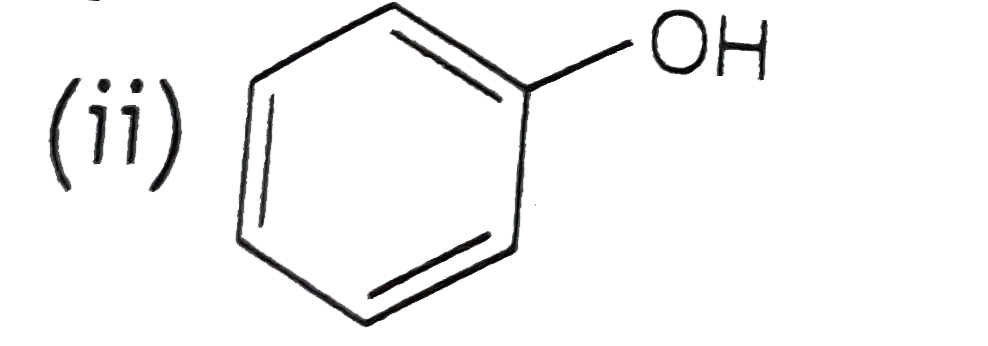Complete Solutions to Short Answer Type Questions of chapter HALOALKANES AND HALOARENES of Class 12 book with complete answers and questions
| Class 12 | CHEMISTRY |
| Chapter | HALOALKANES AND HALOARENES |
| DINESH COMPANION CHEMISTRY | Short Answer Type Questions |
| Number Of Questions | 33 |
| Academic Year | 2023-24 |
Aryl chlorides and bromides can be easily prepared by electrophilic substitution of arenas with chlorine and bromine respectively in the presence of Lewis acid catalyst. But why does preparation of aryl iodides requires presence of an oxidising agent?
View SolutionOut of o- and p-dibromobenzene, which one has higher melting point and why?
View SolutionWhich of the compounds will react faster in `S_(N)1` reaction with `""^(-)OH` ion?
`CH_(3)-CH_(2)-ClorC_(6)H_(5)-CH_(2)-Cl`
View SolutionWhy iodoform has appreciable antiseptic property?
View SolutionHaloarenas are less reactive than haloalkanes and haloalkenes. Explain.
View SolutionDiscuss the role of Lewis acids in the preparation of aryl bromides and chlorides in the dark.
View SolutionWhich of the following compounds (i) and (ii) will not react with a mixture of NaBr and `H_(2)SO_(4)`. Explain why ?
(i) `CH_(3)CH_(2)CH_(2)OH` (ii)
View SolutionWhich of the products will be major product in the reaction given below? Explain
`CH_(3)CH=CH_(2)+Hitounderset((A))(CH_(3)CH_(2)I)+underset((B))(CH_(3)CHICH_(3))`
View SolutionWhy is the solubility of haloalkanes in water very low ?
View SolutionDraw other resonating structures related to the given structure and find out whether the functional group present in the molecule is ortho, para directing or meta directing.

View SolutionClassify the following compounds as primary, secondary and tertiary halides.
(i) 1-bromobut-2-ene
(ii). 4-Bromopent-2-ene
(iii). 2-Bromo-2-methylpropane
View SolutionCompound 'A' with molecular formula `C_(4)H_(9)`Br is treated with aq. KOH solution. The rate of this reaction depends upon the the concentration of the compounds 'A' only. When another optically active isomer 'B' of this compound was treated with aq. KOH solution, the rate of reaction was found to be dependent on concentration of compound and KOH both.
(i) Write down the structural formula of both compounds 'A' and 'B'.
(ii) Out of these two compounds, which one will be converted to the product with inverted configuration.
View SolutionWrite the structures and names of the compounds formed when compound 'A' with molecular formula `C_(7)H_(8)` is treated with `Cl_(2)` in the presence of `FeCl_(3)`
View SolutionIdentify the product A and B formed in the following reaction:
`CH_(3)-CH_(2)-CH=CH-CH_(3)+HCItoA+B`
View Solution
Which of the following compouds will have the highest melting point and why?
View SolutionWrite down the structures and IUPAC name for neo-pentylbromide.
View SolutionA hydrocarbon of molecular mass 72 g `mol^(-1)` gives a single monochloro derivative and two dichloro derivatives on photo chlorination. Give the structure of the hydrocarbon.
View SolutionName of the alkene which will yield/chloro 1-methylcyclohexane by its reaction with HCl. Write the reaction involved.
View SolutionWhich of the following haloalkanes reacts with aqueous KOH most easily ? Explain giving reason.
(i). 1-Bromobutane
(ii) 2-Bromobutane
(iii) 2-Bromo-2-methylpropane
(iv). 2-Chlorobutane.
View SolutionWhy can aryl halides not be prepared by reaction of phenol with HCl in the presence of `ZnCl_(2)`?
View Solution
which of the given compounds would undergo `S_(N^(1))` reaction faster and why?
View SolutionAllyl chloride is hydrolysed more readily than n-propyl chloride. Why ?
View SolutionWhy is it necessary to avoid even traces of moisture during the use of a Grignard reagent ?
View SolutionHow do polar solvents help in the first step in `S_(N)1` mechanism?
View SolutionWrite a test to detect the presence of double bond in a molecule.
View SolutionDiphenyls are potential threat to the envioronment. How are these produced from aryl halides?
View SolutionWhat are the IUPAC names of the insecticide DDT and benzene hexachloride? Why is their use banned in India and other countries?
View SolutionElimination reaction (especially `beta` - elimination) are as common as the nucleophilic substitution reaction in case of alkyl halides. Specify the reagents used in both cases.
View SolutionHow will you obtain bromobenzene from aniline?
View SolutionAryl halides are extremely less reactive towards nucleophilic substitution. Predict and explain the order of reactivity of the following compounds towards nucleophilic substitution.

View Solution Predict the major product formed when HCl is added to isobutylene. Explain the mechanism involved.
Predict the major product formed when HCl is added to isobutylene. Explain the mechanism involved.
View SolutionHow can you obtain iodoethane from ethanol when no other iodine containing reagent except NAI is available in the laboratery?
View SolutionCyanide ion acts as an ambident nucleophille. From which end it acts as a strong nucleophile in aqueous medium? Give reason for your answer.
View Solution
Short Answer Type Questions questions and complete solutions for chapter HALOALKANES AND HALOARENES of S DINESH & CO CHEMISTRY (HINGLISH) of Class 12
All Exercises from DINESH COMPANION CHEMISTRY Class 12 CHEMISTRY HALOALKANES AND HALOARENES
- Additional important questions
- Assertion-Reason Type
- Assignment
- Brain storming multiple choice questions
- Comprehension
- Example
- Haloarenes
- Higher Order Thinking Skills Questions
- Integer
- Jee Main & Other Enginnering Entrance Examination
- Long Answer type Question
- Matrix
- Multiple choice
- NCERT
- Problem for practice
- Question From board Examinations
- Short Answer Type Questions
- Single correct option
- Some typical work problems based on coversions
- Straight Objective type